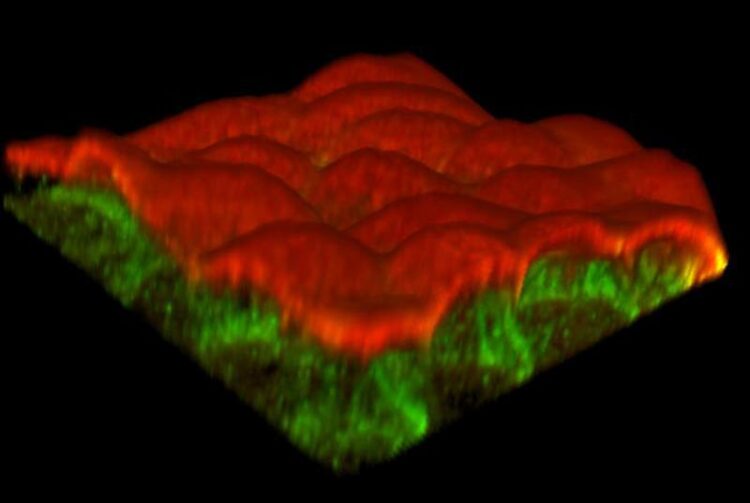Big impacts from small changes in cell

3D microscope image showing separation of actin isoforms in a cluster of cells. The uppermost layer (stained red) consists of gamma actin, whilst the base and edges display beta actin (green), which illustrates that gamma actin prefers to form rigid networks near the cell’s apex while beta actin preferentially forms parallel bundles with a distinct organizational pattern.
Credit: Andreas Janshoff
Research at Göttingen and Warwick Universities reveals how filament interactions affect cellular networks.
Tiny things matter – for instance, one amino acid can completely alter the architecture of the cell. Researchers at the Universities of Göttingen and Warwick investigated the structure and mechanics of the main component of the cytoskeleton of the cell: a protein known as actin. Actin is found in all living cells where it has a range of important functions – from muscle contraction to cell signalling and cell shape. This protein comes in two different varieties termed “isoforms”, which are known as gamma actin and beta actin. The difference between the two proteins is miniscule, only a few amino acids at just one part of the molecule vary. Yet this small change has a big impact on the cell. In nature, normally only mixtures of the two isoforms are found. In their study, the researchers separated out the two isoforms and analyzed them individually. The results were published in the journal Nature Communications.
The researchers studied the behaviour of networks of filaments, particularly focusing on the unique properties of the individual isoforms. They employed specialized techniques allowing them to assess the mechanics and dynamics of research models of cytoskeletal networks, drawing on expertise in biophysics at Göttingen and bioengineering at Warwick.
The results indicate that gamma actin prefers to form rigid networks near the cell’s apex, while beta actin preferentially forms parallel bundles with a distinct organizational pattern. This difference is likely to be due to the stronger interaction of gamma actin with specific types of positively charged ions, rendering its networks stiffer than those formed by beta actin. “Our findings are compelling because they open up new avenues for understanding the intricate dynamics of protein networks within cells,” explains Professor Andreas Janshoff, Institute for Physical Chemistry, University of Göttingen. The research advances scientists’ understanding of fundamental cellular processes by shedding light on specific biological functions of actin, and this will have particular relevance for processes involving cellular mechanics such as growth, division and maturation of cells in tissue. “The implications of these discoveries extend to the broader field of cellular biology, offering insights that could impact many areas of research and applications, for instance in developmental biology,” adds Janshoff.
Original publication: Nietmann et al “Cytosolic actin isoforms form networks with different rheological properties that indicate specific biological function” Nature Communications, DOI: 10.1038/s41467-023-43653-w
Contact:
Professor Andreas Janshoff
University of Göttingen
Institute for Physical Chemistry
Tammannstraße 6, 37077 Göttingen, Germany
Tel: +49 (0)551 39-14411
Email: ajansho@gwdg.de
www.uni-goettingen.de/en/208570.html
Journal: Nature Communications
DOI: 10.1038/s41467-023-43653-w
Method of Research: Experimental study
Subject of Research: Cells
Article Title: Cytosolic actin isoforms form networks with different rheological properties that indicate specific biological function
Article Publication Date: 2-Dec-2023
Media Contact
Melissa Sollich
University of Göttingen
melissa.sollich@uni-goettingen.de
Office: 49-551-392-6228
Original Source
Media Contact
All latest news from the category: Life Sciences and Chemistry
Articles and reports from the Life Sciences and chemistry area deal with applied and basic research into modern biology, chemistry and human medicine.
Valuable information can be found on a range of life sciences fields including bacteriology, biochemistry, bionics, bioinformatics, biophysics, biotechnology, genetics, geobotany, human biology, marine biology, microbiology, molecular biology, cellular biology, zoology, bioinorganic chemistry, microchemistry and environmental chemistry.
Newest articles

A blueprint for mapping melting ice sheets
Researchers in the Stanford Radio Glaciology lab use radio waves to understand rapidly changing ice sheets and their contributions to global sea-level rise. This technique has revealed groundwater beneath Greenland,…

Water hyacinth plant pots – utilization of an invasive species
Together with Fiber Engineering GmbH, the DITF presents a process for the production of biodegradable plant pots. The products are cost effective and competitive. At the same time, the production…

Current research on the new 6G mobile communications standard
Nursing care robots, autonomous driving, digital twins: all of these high-tech applications will play an essential role for the new 6G mobile communications standard. The first commercial 6G networks are…



